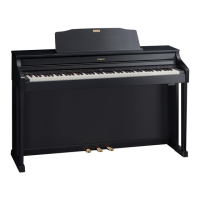Various Settings (Function Mode)
Indication Value Explanation
Center Pedal
Changing How the Pedals Work (Center Pedal)
When you turn on the power, the center pedal functions as the sostenuto pedal (p. 14).
You can change the function of the pedal to a variety of other operations.
Sostenuto Sets function to sostenuto pedal.
Play/Stop
The pedal will have the same function as the [
] (Play/Stop) button.
Layer
Pressing the pedal will layer on Tone 2, used for Dual play.
* The Layer function can be applied only when using Dual play.
Octave
Pressing the pedal will layer on a sound one octave higher.
* The Octave function cannot be applied while using Twin Piano, Dual play, or Split play.
Local Control
Preventing Doubled Notes When Connected to a Sequencer
(Local Control)
When you have a MIDI sequencer connected via USB, set this parameter to Local O.
Since most sequencers have their Thru function turned on, notes you play on the
keyboard may be sounded in duplicate, or get dropped. To prevent this, you can
enable the “Local O” setting so that the keyboard and internal sound generator will be
disconnected.
O
Local Control is o.
The keyboard and composer are disconnected from the internal sound generator. Playing the keyboard will not produce sound.
On
Local Control is on.
The keyboard and composer are connected to the internal sound generator.
MIDI Transmit Channel
MIDI Transmit Channel Settings (MIDI Transmit Channel)
This setting species the MIDI channel on which the HP508 will transmit.
MIDI uses sixteen “MIDI channels,” which are numbered 1 through 16. By connecting MIDI
devices (USB MIDI) and specifying the appropriate MIDI channel for each device, you can play
or select sounds on those devices.
The HP508 will receive all sixteen channels (1–16).
O, 1–16
Save Song
Renaming a Song (Save Song)
Here’s how to rename a song you’ve saved (p. 41).
Copy Song
Copying a Saved Song (Copy Song)
A song you’ve saved to Favorite can be copied to the USB ash drive. Alternatively, a song saved to a USB ash drive can be copied to Favorite (p. 45).
Delete Song
Deleting a Saved Song (Delete Song)
You can delete a saved song from Favorite or the USB ash drive (p. 46).
Format Media
Initializing the Memory (Format Media)
You can delete all songs from Favorite or a separately sold USB ash drive (p. 46).
USB Driver
Changing the USB Driver Settings (USB Driver)
Normally, you don’t need to install a driver in order to connect the HP508 to your computer. However, if some problem occurs,
or if the performance is poor, using the Roland original driver may solve the problem.
In this case, setting “USB Driver” to “Original” on the HP508, install the driver on your personal computer.
After changing this setting, you need to turn o the HP508, then turn it back on again.
MEMO
This setting is automatically saved in the HP508.
For details on downloading and installing the Roland original driver, refer to the Roland website.
Roland website:
http://www.roland.com/
Generic Choose this if you want to use the generic USB driver that was included with your computer. Normally, you should use this mode.
Original Choose this if you want to use a USB driver downloaded from the Roland website.
MIDI
Sequencer
Local Control
Sound Generator
USB MIDI
In
USB MIDI
Out
How to save your settings?
Save your settings as described in “Memory
Backup” (p. 44).
52

